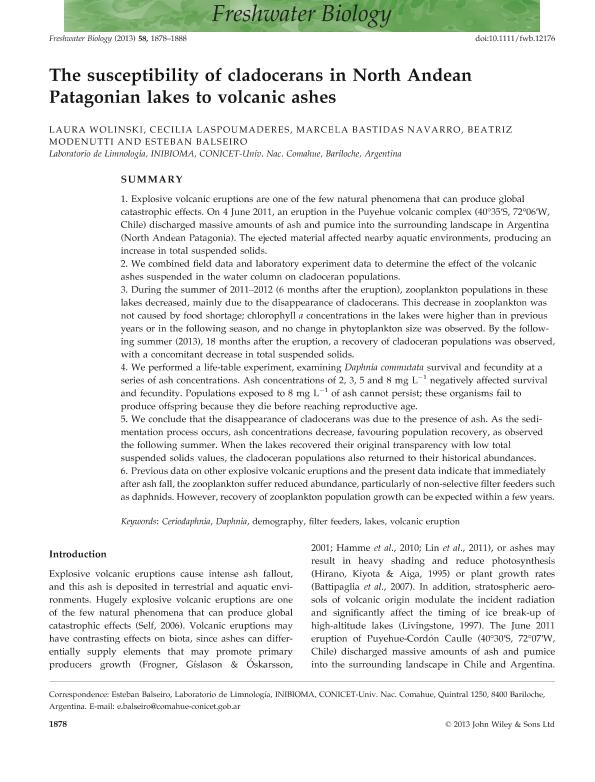Mostrar el registro sencillo del ítem
dc.contributor.author
Wolinski, Laura
dc.contributor.author
Laspoumaderes, Cecilia

dc.contributor.author
Bastidas Navarro, Marcela Alejandra

dc.contributor.author
Modenutti, Beatriz Estela

dc.contributor.author
Balseiro, Esteban Gabriel

dc.date.available
2016-07-29T18:41:17Z
dc.date.issued
2013-05
dc.identifier.citation
Wolinski, Laura; Laspoumaderes, Cecilia; Bastidas Navarro, Marcela Alejandra; Modenutti, Beatriz Estela; Balseiro, Esteban Gabriel; The susceptibility of cladocerans in North Andean Patagonian lakes to volcanic ashes; Wiley; Freshwater Biology (print); 58; 9; 5-2013; 1878-1888
dc.identifier.issn
0046-5070
dc.identifier.uri
http://hdl.handle.net/11336/6817
dc.description.abstract
1. Explosive volcanic eruptions are one of the few natural phenomena that can produce global catastrophic effects. On 4 June 2011, an eruption in the Puyehue volcanic complex (40°35′S, 72°06′W, Chile) discharged massive amounts of ash and pumice into the surrounding landscape in Argentina (North Andean Patagonia). The ejected material affected nearby aquatic environments, producing an increase in total suspended solids. 2. We combined field data and laboratory experiment data to determine the effect of the volcanic ashes suspended in the water column on cladoceran populations. 3. During the summer of 2011?2012 (6 months after the eruption), zooplankton populations in these lakes decreased, mainly due to the disappearance of cladocerans. This decrease in zooplankton was not caused by food shortage; chlorophyll a concentrations in the lakes were higher than in previous years or in the following season, and no change in phytoplankton size was observed. By the following summer (2013), 18 months after the eruption, a recovery of cladoceran populations was observed, with a concomitant decrease in total suspended solids. 4. We performed a life-table experiment, examining Daphnia commutata survival and fecundity at a series of ash concentrations. Ash concentrations of 2, 3, 5 and 8 mg L 1 negatively affected survival and fecundity. Populations exposed to 8 mg L 1 of ash cannot persist; these organisms fail to produce offspring because they die before reaching reproductive age. 5. We conclude that the disappearance of cladocerans was due to the presence of ash. As the sedimentation process occurs, ash concentrations decrease, favouring population recovery, as observed the following summer. When the lakes recovered their original transparency with low total suspended solids values, the cladoceran populations also returned to their historical abundances. 6. Previous data on other explosive volcanic eruptions and the present data indicate that immediately after ash fall, the zooplankton suffer reduced abundance, particularly of non-selective filter feeders such as daphnids. However, recovery of zooplankton population growth can be expected within a few years.
dc.format
application/pdf
dc.language.iso
eng
dc.publisher
Wiley

dc.rights
info:eu-repo/semantics/openAccess
dc.rights.uri
https://creativecommons.org/licenses/by-nc-sa/2.5/ar/
dc.subject
Ceriodaphnia
dc.subject
Daphnia
dc.subject
Demography
dc.subject
Filter Feeders
dc.subject
Lakes
dc.subject
Volcanic Eruption
dc.subject.classification
Ecología

dc.subject.classification
Ciencias Biológicas

dc.subject.classification
CIENCIAS NATURALES Y EXACTAS

dc.title
The susceptibility of cladocerans in North Andean Patagonian lakes to volcanic ashes
dc.type
info:eu-repo/semantics/article
dc.type
info:ar-repo/semantics/artículo
dc.type
info:eu-repo/semantics/publishedVersion
dc.date.updated
2016-07-28T18:32:35Z
dc.journal.volume
58
dc.journal.number
9
dc.journal.pagination
1878-1888
dc.journal.pais
Estados Unidos

dc.journal.ciudad
Hoboken
dc.description.fil
Fil: Wolinski, Laura. Consejo Nacional de Investigaciones Científicas y Técnicas. Centro Científico Tecnológico Patagonia Norte. Instituto de Investigación En Biodiversidad y Medioambiente; Argentina
dc.description.fil
Fil: Laspoumaderes, Cecilia. Consejo Nacional de Investigaciones Científicas y Técnicas. Centro Científico Tecnológico Patagonia Norte. Instituto de Investigación En Biodiversidad y Medioambiente; Argentina
dc.description.fil
Fil: Bastidas Navarro, Marcela Alejandra. Consejo Nacional de Investigaciones Científicas y Técnicas. Centro Científico Tecnológico Patagonia Norte. Instituto de Investigación En Biodiversidad y Medioambiente; Argentina
dc.description.fil
Fil: Modenutti, Beatriz Estela. Consejo Nacional de Investigaciones Científicas y Técnicas. Centro Científico Tecnológico Patagonia Norte. Instituto de Investigación En Biodiversidad y Medioambiente; Argentina
dc.description.fil
Fil: Balseiro, Esteban Gabriel. Consejo Nacional de Investigaciones Científicas y Técnicas. Centro Científico Tecnológico Patagonia Norte. Instituto de Investigación En Biodiversidad y Medioambiente; Argentina
dc.journal.title
Freshwater Biology (print)

dc.relation.alternativeid
info:eu-repo/semantics/altIdentifier/url/http://onlinelibrary.wiley.com/doi/10.1111/fwb.12176/abstract
dc.relation.alternativeid
info:eu-repo/semantics/altIdentifier/doi/10.1111/fwb.12176
dc.relation.alternativeid
info:eu-repo/semantics/altIdentifier/doi/http://dx.doi.org/10.1111/fwb.12176
Archivos asociados
